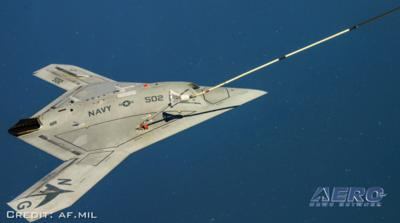Thu, Sep 14, 2017
Intelligence-Gathering A Possible Secondary Mission For The Aircraft
The U.S. Navy is working to finalize its MQ-25 drone program sometime in the next two years with a goal of operating unmanned aircraft off aircraft carriers that are capable of delivering fuel to other aircraft in flight.

Defense News reports that the first MQ-25 drones are set to deploy from the aircraft carriers Dwight C. Eisenhower and George H.W. Bush in 2019, but a deployment date in 2018 is also under considerations. But the Navy will have to make its business case for an earlier deployment.
The success of the program relies heavily on the Unmanned Carrier Aviation Mission Controls System (UMCS). The Common Control System (CCS) for the UMCS is being developed by the Strike Planning and Execution Systems office of the Naval Air Systems Command. Third-party developers will likely be given contracts for vehicle-specific capabilities, according to the report.
The GAO plans to spend in excess of $2 billion for the MQ-25 system. Contractors on the program include Northrop Grumman, General Atomics, Lockheed Martin and Boeing.
If the refueling mission proves successful, the MQ-25 could also be configured for intelligence gathering and surveillance, according to the report.
According to NAVAIR, the MQ-25 will be the first air system procured by the Navy's Unmanned Carrier Aviation Program Office. (PMA-268) It is comprised of three major architectural segments: an Air Segment (AS), a Control System & Connectivity (CS&C) Segment, and a Carrier (CVN) Segment.
AS– Includes the MQ-25 UAS, which is composed of the MQ-25A Stingray air vehicle and associated support and handling equipment including the deck handling system, spares and repair materials.
CS&C – Includes the Unmanned Carrier Aviation (UCA) Mission Control System (UMCS) and its associated communication equipment; the Distributed Common Ground Station-Navy (DCGS-N) mission support functionality; all network based interfaces and routing equipment required to control the Stingray; and all required modifications to existing networks and C4I system infrastructure to enable tasking, collection, processing, exploitation and dissemination (TCPED) of the Stingray’s ISR information.
CVN – Composed of CVN ships’ spaces allocated to UCA as well as installed ship systems and modifications necessary for interface with the Air and CS&C segments. CVN systems important to the MQ-25 include aircraft launch and recovery systems, data dissemination systems (including radio terminals and antennas), and deck operations systems.
(Image from file)
More News
Aero Linx: Transport Canada We are a federal institution, leading the Transport Canada portfolio and working with our partners. Transport Canada is responsible for transportation p>[...]
Gross Navigation Error (GNE) A lateral deviation from a cleared track, normally in excess of 25 Nautical Miles (NM). More stringent standards (for example, 10NM in some parts of th>[...]
From AirVenture 2017 (YouTube Edition): Flight-Proven Booster On Display At AirVenture… EAA AirVenture Oshkosh is known primarily as a celebration of experimental and amateu>[...]
Aircraft Parachute System (CAPS) Was Deployed About 293 Ft Above Ground Level, Which Was Too Low To Allow For Full Deployment Of The Parachute System Analysis: The day before the a>[...]
Also: 48th Annual Air Race Classic, Hot Air Balloon Fire, FAA v Banning 100LL, Complete Remote Pilot The news Piper PA-18 Super Cub owners have been waiting for has finally arrived>[...]
 ANN's Daily Aero-Linx (06.29.25)
ANN's Daily Aero-Linx (06.29.25) ANN's Daily Aero-Term (06.29.25): Gross Navigation Error (GNE)
ANN's Daily Aero-Term (06.29.25): Gross Navigation Error (GNE) Classic Aero-TV: Anticipating Futurespace - Blue Origin Visits Airventure 2017
Classic Aero-TV: Anticipating Futurespace - Blue Origin Visits Airventure 2017 NTSB Final Report: Cirrus SR22
NTSB Final Report: Cirrus SR22 Airborne Affordable Flyers 06.26.25: PA18 Upgrades, Delta Force, Rhinebeck
Airborne Affordable Flyers 06.26.25: PA18 Upgrades, Delta Force, Rhinebeck



